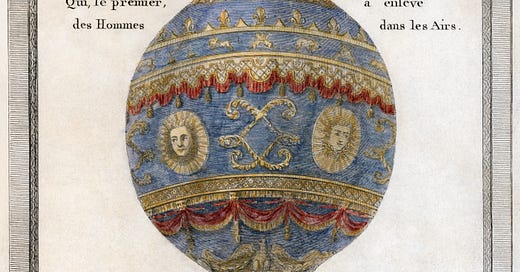Chapter 1.2.VI: Windbags
Notes
For the present, however, consider Longchamp; now when Lent is ending, and the glory of Paris and France has gone forth, as in annual wont. Longchamp is a part of the Bois de Bologne (a large and historic park in Paris) used for horse racing. The “Promenade of Longchamps” had been an important social event since the 1760s, when it became fashionable to hear the nuns at the Abbey of Longchamps sing Tenebrae (“darkness”) a service held on the three days before Easter in which candles are gradual extinguished. The event soon shed its religious significance and became a competition for who could have the most fashionable carriage. In an attempt to curb the sacrilege, Archbishop de Beaumont shut the church to the promenaders, but they kept coming to Longchamps without noticing much change.
Dukes de Liancourt, de la Rochefoucault François Alexandre Frédéric, duc de La Rochefoucauld-Liancourt was a moderate French reformer who tried unsuccessfully to make the monarchy work. He fled France after the storming of the Tuileries.
Prince of Wales Son of King George III, the future King George IV
according to Shakspeare, “butter and eggs” go to market ???
rince d’Artois has withal the strangest horseleech: a moonstruck, much-enduring individual, of Neuchâtel in Switzerland,—named Jean Paul Marat Since 1777, Marat had been the physician of the Duke d'Artois bodyguards. He also ran a successful private practice with other high-status clients before dedicating himself full-time to science
A problematic Chevalier d’Eon, now in petticoats, now in breeches, is no less problematic in London than in Paris; and causes bets and lawsuits An early pioneer of a now-popular movement, Charles d'Éon was a French spy who was also known as Charlotte d'Éon. After spending the first 50 years of his life as a man, he began to live as a woman in 1777 and continued to do so until his death in 1810. Much of his life was spent in Britain, and a betting pool was set up on the London Stock Exchange about his true sex.
curricle-and-four A style of chariot that could fit the driver and a passenger, suitable and fashionable for men who liked to drive themselves
English Dr. Dodd William Dodd, an Anglican clergyman who lived extravagantly and committed forgery in an attempt to get out of his debts; he was tried and hanged in 1777
Duke de Penthievre for Father-in-law The Duke's cousin Louis Jean Marie de Bourbon, who was one of the richest men in France.
(and now the young Brother-in-law Lamballe killed by excesses) The Prince of Lamballe was a hedonist who led a dissipated life and died from a venereal disease at age 20, shortly after his marriage.
for lucre's sake lucre: money, especially when regarded as sordid or gained dishonorably
to lay sacrilegious hand on the Palais-Royal Garden The Palais-Royal was a palace in Paris originally built for Cardinal Richelieu. It was later given by Louis XIV to the Duke of Orléans and remained in their possession through the Revolution. In the early 1780's, Louis Philippe II (future Egalité) carried out a huge construction project where he built new public streets and arcades that were used for shopping.
Philidor, from his Café de la Regence The Café de la Régence was a center of chess near the Palais Royal where all the great chess masters played including François-André Danican Philidor
the Opera Hamadryads fly with shrieks The Palais-Royal also contained one of the main theatres in Paris, which was used by the Opera
things bodily, things spiritual, such as man has not imagined;—and in the Palais-Royal shall again, and more than ever, be the Sorcerer’s Sabbath and Satan-at-Home of our Planet After the construction of the Arcades, the Palais-Royal Gardens became a center for social life and consumption as well as a haunt of prostitutes. Sorcerer's Sabbath refers to the black mass.
Brothers Montgolfier See above, these brothers invented the first hot air balloon to carry a person, which took off in 1783
Ducks and poultry are borne skyward: but now shall men be borne. Earlier in 1783 the brothers had tested their balloons by sending animals up in them
Nay, Chemist Charles thinks of hydrogen and glazed silk. Chemist Charles will himself ascend, from the Tuileries Garden Jacques Alexandre César Charles, another balloonist who went up in his own balloon in December 1783
Turgotine snuff-box, what we call “Turgotine Platitude;” Making fun of Turgot, the name of a popular snuffbox of the time
Duchess Polignac A great beauty of France and a favorite of Marie Antoinette
Pilatre One of the two men who flew in the first Montgolfier balloon, later died in 1784 in an attempt to cross the English Channel in a balloon
Herr Doctor Mesmer Franz Mesmer was a German doctor who came up with a theory of “animal magnetism” that held that there was certain fluids in the body that could be magnetically moved around to cure various illnesses. Mesmer, whose name gives rise to “mesmerize”, would grasp patients hands, rub them, et cetera, curing them, because his animal magnetism was particularly string. The Academy of Sciences investigated and could not confirm the scientific nature of Mesmer's work, leading to his personal falling from favor, though disciples carried on his practice for years and years.


